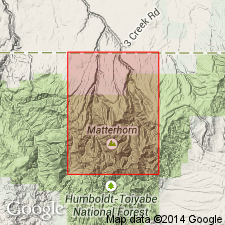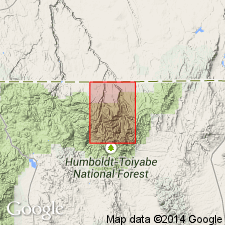
- Usage in publication:
-
- Robinson Creek vitrophyre
- Modifications:
-
- [First used]
- Dominant lithology:
-
- Vitrophyre
- AAPG geologic province:
-
- Great Basin province
Summary:
Pg. 307. Robinson Creek vitrophyre. Several small gray vitrophyric perlite domes, characterized by labradorite, hypersthene, augite, magnetite, and apatite. Maximum exposed thickness of any one dome about 200 feet and greatest length about three-fourths of a mile; generally bases on which domes were extruded not visible. Age is Pliocene. Robinson Creek vitrophyre not adopted by the USGS.
Exposed near northeastern border of Jarbidge quadrangle, Elko Co., northeastern NV.
Source: US geologic names lexicon (USGS Bull. 1200, p. 3300).

- Usage in publication:
-
- Robinson Creek dacite*
- Modifications:
-
- Named
- Dominant lithology:
-
- Dacite
- Perlite
- AAPG geologic province:
-
- Great Basin province
Summary:
Robinson Creek dacite. Exposed only along Jack and Robinson Creeks, central and northeast Jarbidge quadrangle, Elko County, northeastern Nevada, as a number of small intrusive domes of gray vitrophyric perlite, probably of dacitic composition. Characterized by phenocrysts of labradorite or andesine, hypersthene, pigeonite, magnetite, and apatite; zircon, quartz, and sanidine are present in some bodies. Greatest exposed thickness is 200 feet; maximum length of individual bodies is about 0.75 mile. Seems to intrude Jenny Creek tuff (new). One thin dike intrudes lowermost part of Cougar Point welded tuff (new). Older than Banbury formation (redefined). Age is Pliocene, based on stratigraphic position. Report includes geologic map.
Type locality: exposures along Jack Creek and Robinson Creek, central and northeast Jarbidge quadrangle, Elko Co., northeastern NV. Origin of name not stated, but probably named from Robinson Creek.
Source: Modified from GNU records (USGS DDS-6; Denver GNULEX).
For more information, please contact Nancy Stamm, Geologic Names Committee Secretary.
Asterisk (*) indicates published by U.S. Geological Survey authors.
"No current usage" (†) implies that a name has been abandoned or has fallen into disuse. Former usage and, if known, replacement name given in parentheses ( ).
Slash (/) indicates name conflicts with nomenclatural guidelines (CSN, 1933; ACSN, 1961, 1970; NACSN, 1983, 2005, 2021). May be explained within brackets ([ ]).

